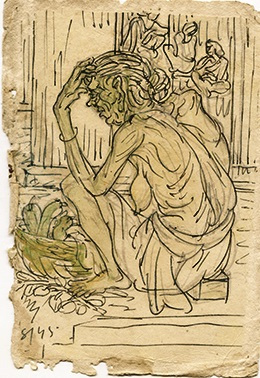The December 3, 2020, exhibition, The Art of the Painted Post Card: Nandalal Bose and His Contemporaries, brought to the fore the practice of some artists adding a sketch or a tiny painting with or without text to these rectangular pieces of cardboard which they mailed to their friends, acolytes and students. The signed post cards that were on display were gifted to the Jadunath Bhavan Museum and Resource Centre by the academic and politician, Malini Bhattacharya. The online exhibition that included specimens of these vehicles of personal interaction of other personalities besides Nandalal (1882-1966) was organized by the JBMRC, Victoria Memorial Hall and DAG Museums. This cache of post cards — many of them fragmenting — was discovered by Bhattacharya after her mother’s death. The exhibition was curated and designed by Tapati Guha-Thakurta, Sujaan Mukherjee and Kamalika Mukherjee.
The bulk of the post cards was sent between 1918 and 1946 by Nandalal to Malini Bhattacharya’s grandfather, Ramesh Charan Basu Majumdar, who was a teacher and himself a competent artist; some specimens of his works were on show too. He lived in various places like Sunamganj in Sylhet, Dhaka and occasionally in Shillong or Allahabad. These post cards, according to the accompanying note by lead curator, Tapati Guha-Thakurta, take us “through the most important years of Nandalal Bose’s artistic career and travels across India and abroad” and throw light on the friendship between Nandalal and Ramesh Charan and some details of the latter’s life and family. Ramesh Charan was denied the pleasure of travelling as he got more deeply involved in his professional and family life, but he could feel the same exhilaration through Nandalal’s eyes as the artist travelled to Tokyo with Rabindranath in 1924 and began to discover India as he journeyed to the caves at Bagh and accompanied Gandhi to Haripura, Faizpur, Porbandar, Dwarika and Kathiawad and many other destinations. The visual cues that accompanied each post card supplemented by a few lines of the text of the epistle take viewers on a virtual tour that most of us fall back on in these trying times.

Post card from the exhibition, The Art of the Painted Post Card: Nandalal Bose and His Contemporaries. JBMRC
Nandalal was still working at Bichitra Club and the Indian Society of Oriental Art in Jorasanko when he began to write to Ramesh Charan in the 1920’s.
The vignettes Nandalal either sketched or painted include pristine landscapes, monuments, animals and human beings he saw around him in unspoiled Santiniketan and during his travels or reproduced from memory long before India was modernized.
There are mountains and wooded hillocks of Darjeeling and Monghyr. Kurseong represented by local people carrying their children on their backs. The Haripura Congress camp becomes a clump of trees while the Faizpur pavilion is represented by the grand gateway, Rani Jhansi Darwaza. Puri turns into billowing and crashing ornamental waves. Nandalal literally turned the Bagh caves into a tiger. He made a deft pencil sketch of a turbaned, wiry man in traditional attire familiar to viewers through films like Bhuvan Shome and Manthan in Porbandar or Sudamapuri. Nandalal drew two women cooking — one old and shrivelled with hanging breasts (picture, left), the other like a budding bloom. Echoes of Sahaj Path.
Nandalal’s sense of humour sparkles in his sketch of a toothless lion that he compared to himself and his inability to comprehend the works of contemporary artists in the Marg Deepavali issue of 1954.











